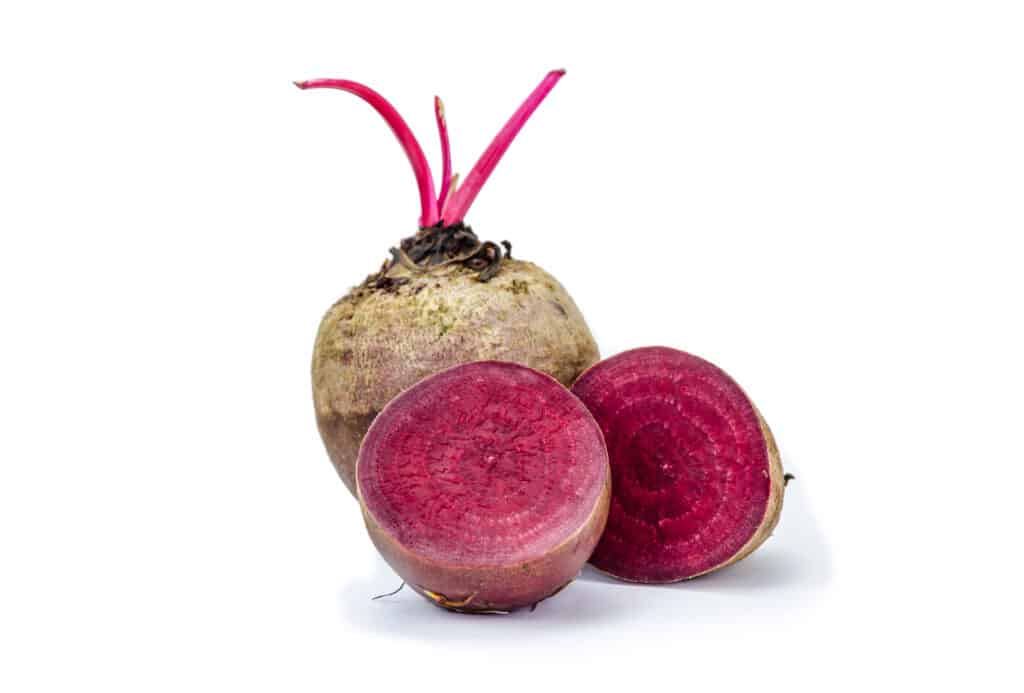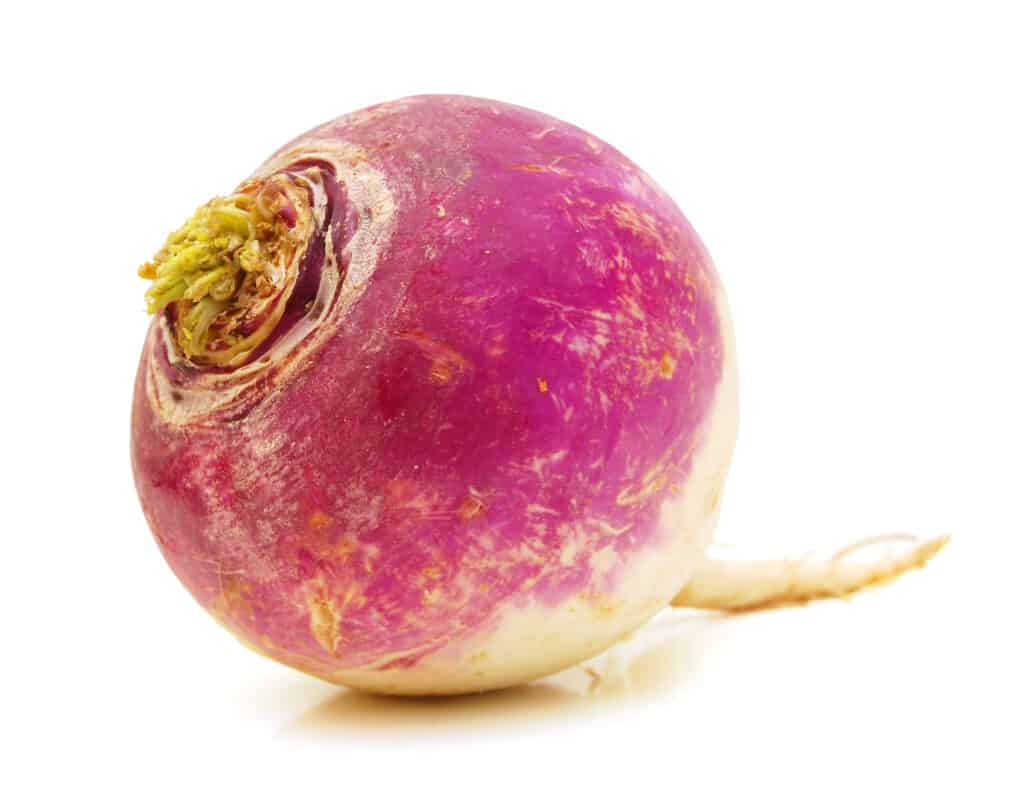Turnips and beets are prized for their delicious underground root and nutritious above-ground foliage. They are ancient plants that have sustained humans with valuable carbohydrates and antioxidants for thousands of years. These plants are both very easy to grow and keep in storage for several months. There are a few differences, so let’s explore turnip vs. beet!
Comparing Turnip vs Beet
| Characteristics | Turnip | Beet |
|---|---|---|
| Scientific Family | Brassica rapa | Beta vulgaris |
| Description | White, fleshy taproot. Globular with green leaves | Red or purple, flesh taproot. Globular. Leaves are green with red veins. |
| Size | Two to three inches in diameter. | Four inches in diameter |
| Native Region | Western Asia and Europe | Coastal Europe, Sweden, British Isles |
| Taste | Sweet, nutty, and earthy | Deeply earthy and sweet with a hint of bitterness |
| Uses | Boil, roast, raw, mash, bake, stew, soup, stir-fry, coleslaw. Leaves raw or cooked | Boil, roast, raw, pickle, salad, dip, juice. Leaves raw or cooked |
| Time to Harvest | 60 days | 55-70 days |
| Growing Requirements | Cool season, plant in spring or fall. Plant seeds directly, do not transplant. Evenly water and provide mulch. | Cool season, plant in spring or fall. Plant seeds directly, do not transplant. Evenly water and provide mulch. |
| Storage | 5-7 days in the refrigerator. 4 months in the root cellar | 5-7 days in the refrigerator. 2-5 months in the root cellar |
The 5 Key Differences Between Turnip and Beet

Beets are a rich reddish-pink color inside
©Pingun/Shutterstock.com
The main difference between turnips and beets is in the color of flesh and the color of skin. The two plants are also used for different culinary purposes and grow to different sizes. We will discuss these differences in more detail now.
Turnip vs. Beet: Appearance
If you are holding a beet and a turnip side by side, you will undoubtedly be able to tell them apart. The beet is a dark red root vegetable with green red-veined leaves. The turnip is a white, round root vegetable with purely green leaves. Most gardeners pick beets and turnips when they are three or four inches in diameter, although they will grow much bigger if left in the ground long enough.
Beets come in red, yellow, orange, and multi-colored striped varieties. The color of the beet skin is also the color of the flesh. Turnips come in white-skinned or purple-skinned varieties, but all have white flesh.
Turnip vs. Beet: Uses

Tunips are commonly used the same way as potatoes and carrots are.
©Tiger Images/Shutterstock.com
Cooks use turnips in the same ways that carrots or potatoes are used. They are commonly mashed, baked in casseroles, cooked into stews, and roasted. The leaves are also highly nutritious and edible. The leaves can be eaten raw or cooked.
Cooks use beets differently, such as pickled, juiced, and pureed into a dip. Because of their bright red color, they are not often cooked into stews, soups, or casseroles because they tend to dye the whole lot red. Cooks who love beets use golden-colored beets for those applications.
Turnip vs. Beet: Growing Requirements
Turnips and beets are both cool-season root vegetables. Neither can handle hot summers, so gardeners plant them in the spring or fall when temperatures are cooler. Both plants prefer weed-free and loose soil so they can quickly grow downward.
They cannot handle transplanting, and the seeds are best directly sowed into the soil. Plant the seeds half an inch deep and one or two inches apart. After the seedlings emerge, thin the plants to four inches apart by trimming off the crowded plants with a pair of scissors.
Upon planting, provide even moisture for the remainder of the growing season. After the seedlings have sprouted, provide mulch to cover the soil, prevent weeds and retain moisture.
Beets will be ready to harvest in 55 to 70 days. Turnips will be ready to harvest in 50 days. Harvest when they are golf ball size or larger. Don’t wait too long, as they get woody and tough if allowed to grow too large.
Turnip vs. Beet: Size
Both turnips and beets are normally harvested when they are three or four inches in diameter. This gives the best flavor and texture.
However, root vegetables will keep growing if left in the soil. The heaviest turnip ever recorded was 39 pounds 3 ounces! The heaviest beet was 51 pounds 9.4 ounces!
Turnip vs. Beet: Storage
Beets and turnips will keep in the refrigerator for about one week. A cold, dark place is best if you want to keep them for long-term storage. You can keep many types of root vegetables for months if you have access to a basement, cold garage, or root cellar.
The ideal conditions to store a turnip are temperatures between 32 and 38°F and humidity of 90% or more. Store in moist sand in a dark place for up to four months, often checking for rot. Turnips can also be frozen or canned to preserve.
The ideal conditions to store a beet are temperatures between 33 to 40°F and humidity of 90% or more. Store in dry sand or sawdust in a dark place for 2 to 5 months. Beets can also be frozen, canned, or pickled to preserve.
Up Next
- Golden Beet vs Red Beet: Is There a Difference?
- Turnip Seeds: How to Sow and Harvest This Fast-Growing Root!
- 11 Vegetables to Plant in October.
The photo featured at the top of this post is © Pingun/Shutterstock.com
Thank you for reading! Have some feedback for us? Contact the AZ Animals editorial team.







